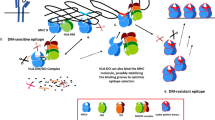Abstract
THE mutant human cell line T2 is defective in antigen presentation in the context of class I major histocompatibility complex (MHC) molecules1,2 and also in that transfected T2 cells show poor surface expression of exogenous human class I (HLA) alleles3. Both defects are thought to lie in the transport of antigenic peptides derived from cytosolic proteins into the endoplasmic reticulum (ER)1,2 as peptide-deficient class I molecules might be expected to be either unstable or retained in the ER4. The products of several mouse class I (H–2) genes, and the endogenous gene HLA-A2 do, however, reach the surface of T2 cells at reasonable levels although they are non-functional3,5,6. We report here that, as expected, poorly surface-expressed HLA molecules do not significantly bind endogenous peptides. Surprisingly, H–2 omolecules expressed in T2 also lack associated peptides, arguing that 'empty' complexes of mouse class I glycoproteins with human β2-microglobulin are neither retained in the ER nor unstable. HLA-A2 molecules, however, do bind high levels of a limited set of endogenous peptides. We have sequenced three of these peptides and find that two, a 9-mer and an 11-mer, are derived from a putative signal sequence (of IP-30, an interferon-γ-inducible protein7), whereas a third, a 13-mer, is of unknown origin. The unusual length of two of the peptides argues that the 9-mers normally associated with HLA-A2 molecules may be generated before their transport from the cytosol rather than in a pre-Golgi compartment. To our knowledge, this is the first report of the isolation of a fragment of a eukaryotic signal peptide generated in vivo.
Similar content being viewed by others
References
Townsend, A. et al. Nature 340, 443–448 (1989).
Anderson, K. et al. J. exp. Med. 174, 489–492 (1991).
Alexander, J., Payne, J. A., Murray, R., Frelinger, J. A. & Cresswell, P. Immunogenetics 29, 380–388 (1989).
Ljunggren, H-G. et al. Nature 346, 476–480 (1990).
Cerundolo, V. et al. Nature 345, 449–452 (1990).
Hosken, N. A. & Bevan, M. J. Science 248, 367–370 (1990).
Luster, A. D., Weinshank, R. L., Feinman, R. & Ravetch, J. V. J. biol Chem. 263, 12036–12043 (1988).
Van Bleek, G. M. & Nathenson, S. G. Nature 348, 213–216 (1990).
DeMars, R., Chang, C. C., Shaw, S., Reitnauer, P. J. & Sondel, P. M. Hum. Immun. 11, 77–97 (1984).
Salter, R. D., Howell, D. N. & Cresswell, P. Immunogenetics 21, 235–246 (1985).
Gotch, F., Rothbard, J. Howland, K., Townsend, A. & McMichael, A. Nature 326, 881–882 (1987).
Falk, K., Rotzsche, O., Stevanovic, S., Jung, G. & Rammensee, H-G. Nature 351, 290–296 (1991).
Spies, T. & DeMars, R. Nature 351, 323–324 (1991).
Trowsdale, J. et al. Nature 348, 741–744 (1990).
Spies, T. et al. Nature 348, 744–747 (1990).
Alexander, J., Payne, J. A., Shigekawa, B., Frelinger, J. A. & Cresswell, P. Immunogenetics 31, 169–178 (1990).
Madden, D. R., Gorga, J. C. Strominger, J. L. & Wiley, D. C. Nature 353, 321–325 (1991).
Cerundolo, V. et al. Eur. J. Immun. 21, 2069–2075 (1991).
Townsend, A. et al. Cell 62, 285–295 (1990).
Brown, M. G., Driscoll, J. & Monaco J. J. Nature 353, 355–357 (1991).
Glynne, R. et al. Nature 353, 357–360 (1991).
Ortiz-Navarrete, V. et al. Nature 353, 662–664 (1991).
Harmon, R. C., Stein, N. & Frelinger, J. A. Immunogenetics 18, 541–545 (1983).
Ozato, K. & Sachs, D. H. J. Immun. 126, 317–321 (1981).
Berger, A. E., Davis, J. E. & Cresswell, P. Hybridoma 1, 87–90 (1982).
Davis, J. E. & Cresswell, P. J. Immun. 144, 990–997 (1990).
Brodsky, F. M., Parham, P., Barnstable, C. J., Crumpton, M. J. & Bodmer, W. F. Immunol. Rev. 47, 3–61 (1979).
Parham, P., Barnstable, C. J. & Bodmer, W. F. J. Immun. 123, 342–349 (1979).
Roche, P. A. & Cresswell, P. J. Immun. 144, 1849–1856 (1990).
Author information
Authors and Affiliations
Rights and permissions
About this article
Cite this article
Wei, M., Cresswell, P. HLA-A2 molecules in an antigen-processing mutant cell contain signal sequence-derived peptides. Nature 356, 443–446 (1992). https://doi.org/10.1038/356443a0
Received:
Accepted:
Issue Date:
DOI: https://doi.org/10.1038/356443a0
- Springer Nature Limited
This article is cited by
-
In vivo CRISPR screens reveal Serpinb9 and Adam2 as regulators of immune therapy response in lung cancer
Nature Communications (2023)
-
Cross-presentation of a TAP-independent signal peptide induces CD8 T immunity to escaped cancers but necessitates anchor replacement
Cancer Immunology, Immunotherapy (2022)
-
A personal retrospective on the mechanisms of antigen processing
Immunogenetics (2019)
-
Nonstimulatory peptide–MHC enhances human T-cell antigen-specific responses by amplifying proximal TCR signaling
Nature Communications (2018)
-
Improved Transgenic Mouse Model for Studying HLA Class I Antigen Presentation
Scientific Reports (2016)





